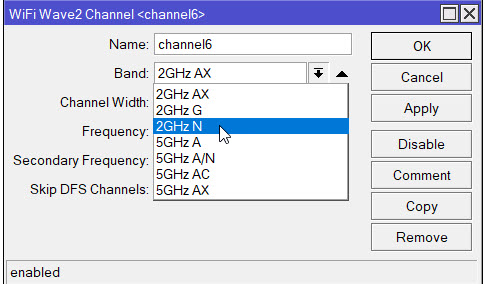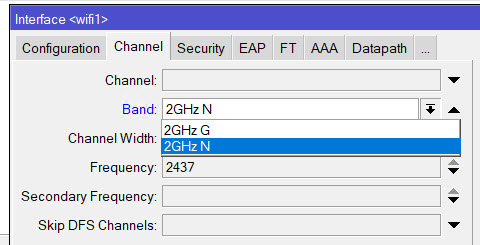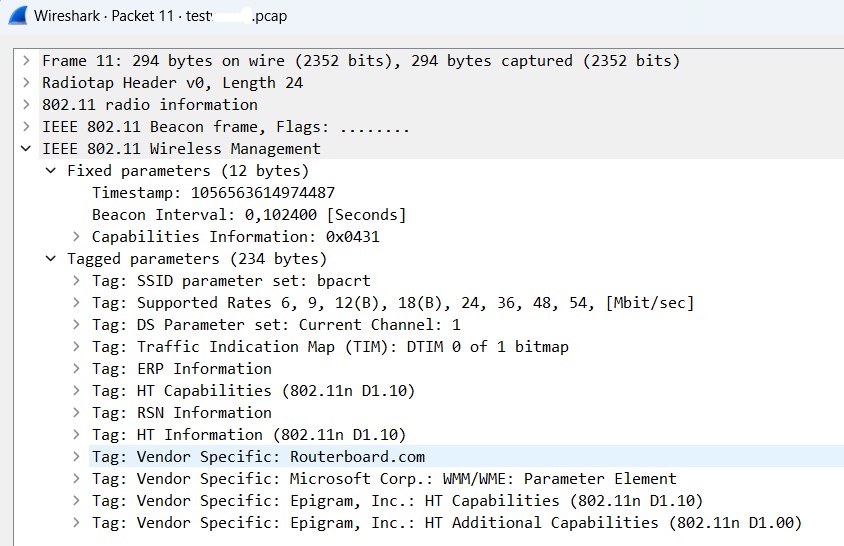With wave2 packet 2.4 GHz AP broadcast g/n/ac standarts. There are no option to choose only N anymore?
From what I can see, it can still be done.
What device do you have ?
And be aware that band/channel can be set on multiple places, in Winbox left to right has priority.
(First Wifiwave2 interface, then configuration, then channel)

ac3.
No, WifiInfoView shows 802.11g/n when this option is selected. I think this option means the maximum supported standard. Unfortunately, the Wave2 documentation page is more like a summary than a manual.
AC3 using wifiwave2
Only-N is available.

You sure that is Only-N? Because as I said, WifiViewInfo from Nirsoft says, I have G/N wifi now.
Are you equally sure that app is giving you the correct info ?
If I connect with my laptop to an SSID only configured as N, it shows N. Not G/N.
Set the radio to G only.
What does that app show then ?
Windows laptop, right? I’m sure it shows you current protocol, not all supported. But anyway I don’t know other app to check this. Do you?
I don’t have any devices at home or work not supporting N. So I usually set all my 2.4GHz APs to N-only.
I am trying to understand what the relevance is for what is being shown or not in your app.
If it works with “N only”, what’s the problem ?
I’m guessing that OP has same dilemma as I have (or, rather, I don’t have) with this setting: which is that in wifiwave2 it’s actually not “N only”, it’s “up to N”. This is backed up by my own observations in early days of ROS v7 when I set the 5GHz interface to “5ghz-ac” … and then I have a few elderly devices which definitely don’t support AC, they are N … and they happily connect to the AP. At the same time newer AC+ devices enjoy higher throughputs supported by AC.
And then one comes to the pain: why should we step back and support legacy wireless technologies (such as A, B, G) on an AC or AX hardware? We all know that simply announcing legacy technologies takes away a few percent of performance and additionally keeps devices connected to AP in very poor radio conditions (because those legacy technologies work a tiny bit farther away from AP) while we really don’t care about that poor wireless link performance (almost worse than nothing).
Ah yes, the slowest one dictates the pace for the rest.
That’s indeed something to take into account.
Just did a test with mAP connecting to AX3 (don’t have AC3 here with me right now).
Why mAP ? Since I know it can handle the older bands on 2.4GHz just fine.
AX3 is configured for 2.4GHz as AX.
Connecting mAP in station mode to network being serviced by AX3.
When using B on mAP → no connection (but I think AX devices can not handle B anymore, it’s not in the list of possible bands)
When using G on mAP → no connection
When using N on mAP → connection (shows in status as gn)
When using G/N or B/G/N → connection (shows in status as gn)
Smartphone connected to the same SSID, shows no real different result in speed when I run internal speedtest regardless if mAP is connected or not.
AFAIK “802.11n Greenfield” mode has been abandonned by most vendors, because it harms if B or G transmissions are in the same area.
So now in most cases the G compatibility mode is turned on.
FYI: https://www.computerweekly.com/news/2240101850/What-is-80211n-Greenfield-mode
To know what you have, I use to read what is in the beacon.
How to capture a beacon? Either by softwre on a laptop, like inSIDDer, which will collect one sample for every SSID around for you.
Or just use your Mikrotik, like the mAP, with the wifi Sniffer (not that other sniffer in tools). Download file, rename to *.pcap and open the capture with Wireshark for reading and showing the information with a lot of detail.
HT is mode “n”
VHT is mode “ac”
Supported rates 6 till 54 is mode “g”
Just an exemple (classic driver) of wireshark

Interesting mechanism. That’s an article from 2008 ??
Reminds me of good’ol RS-232 hardware flow control ![]()